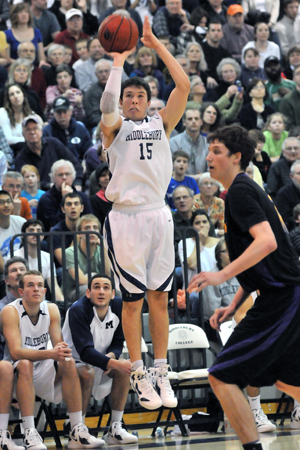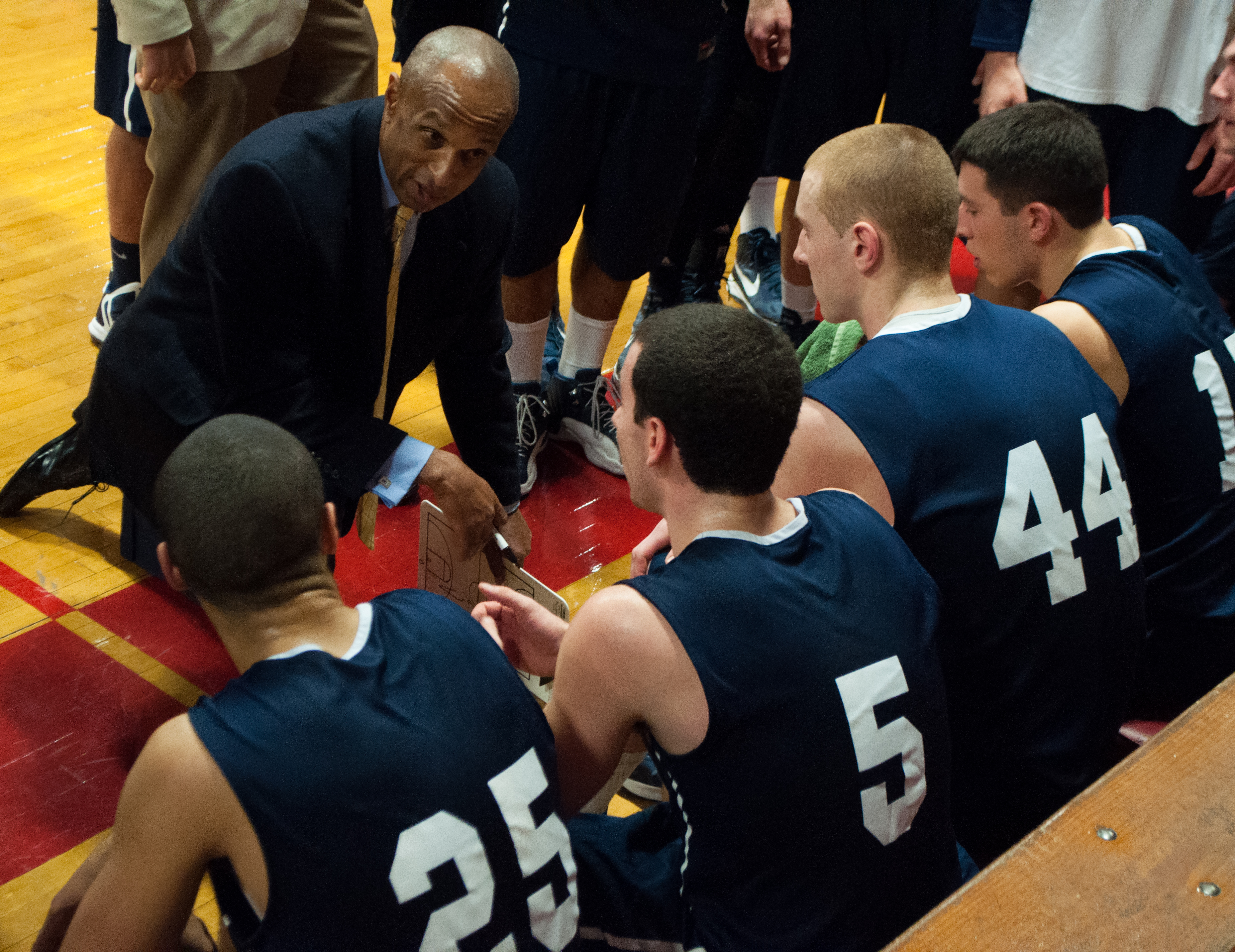Over the last four years, the Middlebury student body has embraced the success of the men’s basketball team, which has won more games than any other Division III team over that period. That support is particularly evident during J-Term, when, unlike students at many other schools who are still on winter vacation, the Middlebury student body is at full capacity and has time to spare. Given the popularity of last year’s team, it’s fair to expect that droves of students will be attending just about every home game from here on out. With that in mind, we decided to compile a list of some of the small things that this team, and individual players do so well. If you’re heading to tonight’s game, or the Wesleyan game tomorrow, here are a couple of things to keep an eye on.
1) How Nolan Thompson defends ball screens: Nolan is, quite simply, as good a perimeter defender as I’ve seen at any level of basketball. Number 25 is as consistent a player as you will see, and does almost everything well on the defensive end. Having said that, his ability to slip through ball screens is exceptional and stands out when you watch him play. Because he is so often asked to guard the best scorer on the other team, Nolan frequently guards guys who are constantly around the ball and often coming off of ball screens. A large part of being a great defender is positioning in anticipation of the play around you. Nolan’s ability to get under or over screens without losing his defensive leverage is all about positioning and anticipation. Before an opposing player can set a pick on Nolan, he either steps inside the screen, hugging his man without fouling or retreats underneath the incoming screen, rendering the pick irrelevant without sacrificing his defensive positioning or giving his man a lane to the basket. If you appreciate basketball, and the intricacies of how the game is played, Nolan Thompson is as fun to watch as it gets.
2) Peter Lynch’s footwork in the post: An undersized power forward, Lynch is generously listed at 6’6”, making his style of play that much more impressive. As a junior last year Lynch shot better than 63% from the field, the best mark in the NESCAC. While Lynch is one of the strongest players in the conference, trailing possibly only Amherst’s Pete Kaasila in brawn, it’s his footwork that separates him from other post-up players. Consider for a moment that Kaasila, who’s 6’9” and 260 pounds scored just 6.8 points per game last season while shooting 57% from the floor. Lynch meanwhile, scored 9.8 points per game and was the most efficient big man in the conference. This year both big men are shooting better than 66% from the floor, but Lynch is averaging nearly five points per game more. The difference between Lynch and Kaasila — the three inches and 45 pounds aside — is in their footwork. Kaasila is a good finisher and has an array of post moves, including a deft hook shot, but does not have the foot speed or the balance that Lynch has. Lynch’s ability to maneuver in the post is so good, it can get him into trouble — he was called for four travels in the Panthers’ recent win over Bates. “Pete’s footwork is so advanced that referees are occasionally perplexed by it,” said assistant coach Alex Popp. “Coach Russ Reilly is the best big man coach in Division III basketball, and he has worked with Lynch and his footwork for four years.”
3) The court vision of Jake Wolfin: It’s hard to say that there’s a common misconception about something related to Middlebury sports, because that requires there to be a collective opinion about the particularities of Middlebury sports and that’s a stretch. However, during my time covering Middlebury sports, the player who students most often misunderstand is Wolfin. They think he turns the ball over too much, or shoots too many quick jumpers. Well, last season Wolfin led the NESCAC in assists (5.2 per game) and had the fifth best assist-to-turnover ratio in the conference, ahead of 1st team NESCAC selections Aaron Toomey and Shasha Brown. Of course Wolfin turns the ball over, but far too many people are concerned primarily with his turnover rate. What they don’t see is what Jake sees — and that makes him different. Number 5 has NBA-level court vision and is the primary reason Middlebury scores so efficiently from the floor. He passes teammates open and is second to none when he’s leading the break, which includes his pull up jumpers in transition (PUJIT), which are, contrary to popular belief, an effective transition shot. First, PUJITs expand the floor and keep defenders from collapsing the lane; second, when Wolfin takes a jumper on the fast break, it almost always comes in rhythm and when he has a clean, open look at the basket, which means he’s more likely to make the shot. With Wolfin shooting 39% from three on the season, the pull up three is a good shot. And finally, if he does miss, his teammates running down the court are in great rebounding position to collect the loose ball.
4) James Jensen’s defensive versatility: Jensen will receive strong consideration next year for NESCAC Defensive Player of the Year. He is the NESCAC version of Tayshaun Prince: his length and quickness allow him to guard everything from interior post players who play with their back to the basket to ultra-quick point guards — both of which he has guarded this season. Amherst forward and reigning NESCAC Defensive Player of the Year Willy Workman is the only other NESCAC player for whom that’s true; Jensen is in rare company. With plus defenders in Kizel and Wolfin, Middlebury already has a good defensive backcourt. Adding Thompson and Jensen into the mix is hardly fair. Both can guard just about any kind of backcourt player, and Jensen’s ability extends into the front court. The number of guys he can’t guard fits on one hand. In particular, watch him next time he lines up opposite the opposing point guard. Notice how he stays low, maintains his defensive stance and uses his legs first to stay in front of his man before using his arms to disrupt the passing lane and affect shots.
5) Joey Kizel’s finishing ability: Kizel can score in so many different ways. He can get to the basket, where he finishes as well as any guard in the conference. Though he’s a selective shooter, Kizel takes, and makes, a high number of shots with an incredibly high degree of difficulty. In particular, Kizel has mastered the step back jumper, which he often utilizes from the elbow area late in the shot clock to get enough separation to release his shot. If you’ve read this blog, then you know that Kizel had an incredibly efficient season last year, posting a .537/.506/.912 line (FG/3PT/FT percentage). Exactly zero NBA players in history, according to basketballreference.com have finished a season shooting better than 53% from the floor, 50% from three and 91% from the line as Kizel did last season. Only seven players in the history of the NBA have had .500/.400/.900 seasons: Dirk Nowitzki, Mark Price, Kevin Durant, Reggie Miller and Jose Calderon have all done it once, while Larry Bird accomplished it twice and Steve Nash has done it a stunning four times. Of all of them, Nash is the only player in NBA history to finish a season better than .500/.470/.900 (http://bkref.com/tiny/LapyN), but still finished with worse numbers than Kizel in every category. While Kizel doesn’t face the same caliber defense that Nash and others face, and his season is only 30 games long compared to the 82-game NBA schedule, Kizel shot a better free throw percentage — a shot that is no more difficult in the pros than in college — than Nash during his 2007-08 MVP season and exceeded the free throw shooting of seven of the 11 combined seasons between the other guys on the list. If you’re worried about sample size, Kizel made 114 of the 125 free throws he took last year, eclipsing the number of made and attempted free throws of Calderon (109-120) during the 2007-08 season. Popp attributes Kizel’s tremendous success to his methodical approach. “Joey Kizel’s patience to take what the defensive gives him [jumps out at me],” he said. “Coming off a 1st-Team All NESCAC season, you would anticipate a player of his status to look for his own more. Not Kizel. He is as patient as it gets. His unparalleled ability to let plays develop on both ends of the floor is very, very special.”
This Middlebury basketball team separates itself from the competition not because it is more athletic or physically imposing than other teams, but because it does the little things right. Team-first players are hard to come by and this roster is chalk full of those kinds of guys. If you enjoy the nuances and intricacies of the game of basketball, as we do, there is no better team to watch at the D-III level. Enjoy.




